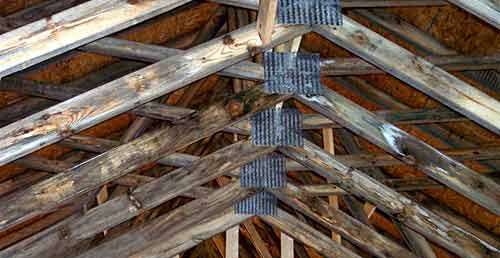Preventing Moisture-Related Problems in Residential Wood Framing
Learning Objectives:
- Explain the moisture-related problems that plague wood frames in homes and multi-dwelling units.
- Describe three preventative treatments that protect wood frames from mold, fungi rot, and termites.
- Compare and contrast preventative treatments with regard to environmental impact, ease of installation, and influence to the wood components.
Credits:
There is a popular phrase in the construction industry, "Don't worry about the problems you can see, worry about the problems you can't." This is especially true when discussing moisture-related problems such as mold, fungi rot, and termites. The seeds of potential moisture problems are present in rainfall and humidity during the construction process and then released daily into the air through cooking, showers, and air conditioning. Unfortunately, these problems can begin to develop deep within the structure of the home behind layers of plaster and drywall, underneath tile and linoleum, or growing unnoticed in attics and basements. The scale of the problem and, subsequently, the cost of the repair are exponentially larger by the time the greenish-black fuzz creeps into plain view or a homeowner's foot breaks through the floor in their kitchen nook.
Beyond the significant impact to the physical structure, moisture-related problems can dramatically affect the health of homeowners and their guests. Allergic reactions, flu-like symptoms, rashes, asthma, air illness, and even deaths have been caused by uncontrolled moisture that creates an environment ripe with molds and toxins that infect the indoor air quality day after day.
There is an estimated $9-10 billion spent to correct construction defects each year. 80 percent of those defects are moisture-related. 41 percent of the moisture-related problems developed in the envelope of the building. There are two reasons for the prevalence of moisture-related problems growing in the internal structure of homes and multi-family dwellings. First, moisture is everywhere. Second, there are weaknesses inherent in the wood materials most commonly used for the building frame that make them susceptible to these problems.
Strengths and Weaknesses of Wood Framing
Today, untreated or white wood, in its many forms, is used throughout 95 percent of the residential and multi-family homes in the United States. Wood is a very popular building material for a wide variety of reasons. It is a readily available, replaceable, natural resource. It is also easy to work with, cost-efficient and available in different forms that offer varying degrees of flexibility, strength, and size.
The framing package of a house often includes dimension lumber, plywood, oriented-strand-board, and engineered wood products. Dimension lumber is a solid piece of wood often referred to simply by its dimensions, a 2x4, 2x8, etc. Plywood is thin layers of wood (plies) glued together and ordered by the number of plies, for example, 4-ply, 5-ply, etc. Oriented-strand-board (OSB) is created by compacting many 1-inch x 1-inch wood chips together. Engineered wood products (EWP) combine large wood chips and small wood chips to create the required board size. EWP supports more weight and structural load in floors and ceilings than the original dimension boards.
|
Despite all of the reasons that wood has become such a popular framing material, there are significant weaknesses in untreated wood that make this material susceptible to moisture-related problems. Wood is an organic natural resource and, as such, occupies a spot in the food chain. Wood and the cellulose inside wood are a food source for decay fungi, mold, termites and other wood ingesting insects. It is also susceptible to dimensional instability, racks, splits and bows.










